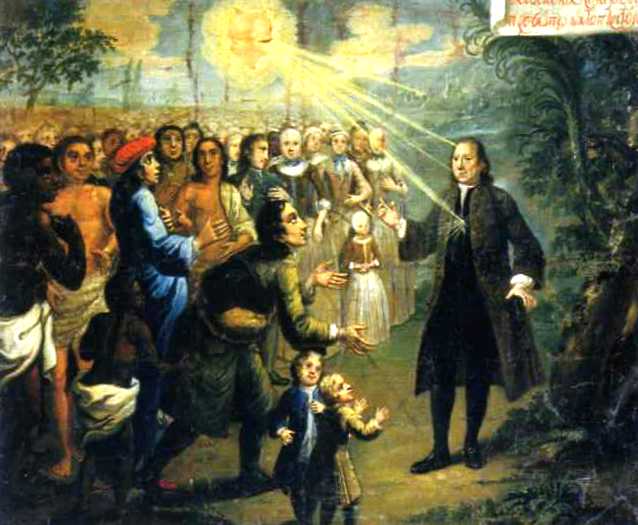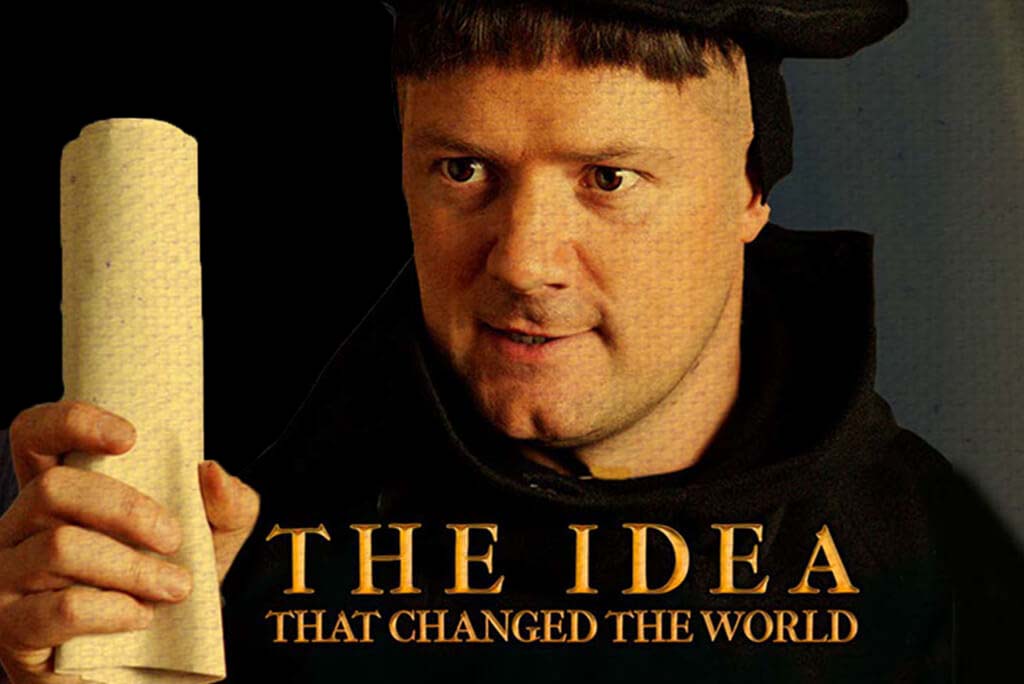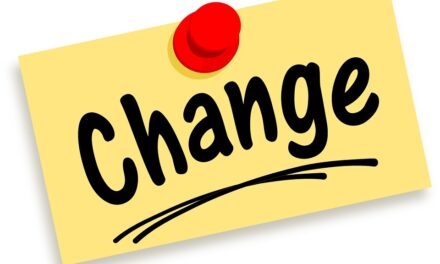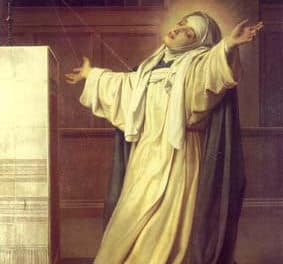The title of this episode is Moravians and Wesley.
We took a look at Pietism in an earlier episode. Pietism was a reaction to the dry dogmatism of Protestant Scholasticism and the reductionist rationalism of Enlightenment philosophers. It aimed to renew a living faith in a living Christ.
As a movement, it was led in the 17th C by Philip Jakob Spener and August Francke.
Spener’s godson was a German Count named Nikolaus Ludwig von Zinzendorf, who even as a child bore a deep devotion to God. His parents were devout Pietists and sent him to the University of Halle, where he studied under the Pietist leader Francke. Later he went to Wittenberg, a center of Lutheran orthodoxy, where he repeatedly clashed with his teachers. After travel and study at law, he married and entered the service of the Court of Dresden. There Zinzendorf first met a group of Moravians who changed the course of his life.
Moravia lies in the southeast of what today is the Czech Republic. Moravians were Hussites; long-time adherents to the renewal begun by Jan Hus. They were forced by persecution to forsake their native lands. Zinzendorf offered them asylum. There they founded the community of Herrnhut. It so appealed to Zinzendorf he resigned his cushy post in Dresden and joined it. Under his direction, the Moravians became part of the local Lutheran parish. But the Lutherans were unwilling to trust foreigners who were also Pietists.
In 1731, while visiting Denmark, Zinzendorf met a group of Inuit believers brought to faith in Christ by the Lutheran missionary Hans Egede. This kindled in the Count an interest in missions that would dominate the rest of his life. Soon the community at Herrnhut was on fire with the same zeal, and in 1732 its first missionaries left for the Caribbean. A few years later there were Moravian missionaries in Africa, India, and the Americas. They founded the communities of Bethlehem and Nazareth in Pennsylvania, and Salem, North Carolina. In just twenty years a movement that began with two hundred refugees had more missionaries overseas than had been sent out by all Protestant churches since the Protestant Reformation a couple of centuries earlier.
In the meantime, conflicts with Lutherans back home in Germany grew. Zinzendorf was banned from Saxony and traveled to North America, where in 1741 he was present at the founding of the Bethlehem township. Shortly after his return to home, peace was hammered out between Lutherans and Moravians. It failed to last. Zinzendorf agreed to become a bishop for the Moravians, from a spiritual line of ecclesiastical authority reaching back to Jan Hus. Lutherans didn’t recognize Hus; they wanted the Count’s authority to link to Luther. This is odd since Luther honored Hus as an influence in the development of his own ideas.
A personal aside. What silly things Christians bicker over. Doesn’t a person’s spiritual authority rest in their being called by God, not man? What matter is it that it comes through this or that one-time leader? It’s the original source that matters.
Zinzendorf died at Herrnhut in 1760, and shortly after, his followers broke with Lutheranism. Although the Moravian church never had a large membership and was unable to continue sending so many missionaries, its example contributed to the great missionary awakening of the 19th C. Perhaps the greatest significance of the movement was its impact on John Wesley and, through him, the Methodist tradition.
In late 1735, early ‘36, a group of Moravians sailed to North America hoping to preach to the Indians of Georgia. Onboard was a young Anglican priest, named John Wesley, whom the Georgia Governor Oglethorpe had invited to serve as a pastor in Savannah. The young Wesley accepted the offer and hoped to preach to Indians. The early part of the voyage was calm and Wesley learned enough German to communicate with the Moravians. Then the weather turned and the ship was soon in real danger. The mainmast split, and panic nearly ruined the crew. The Moravians, by contrast were utterly calm and sang hymns throughout the ordeal. Meanwhile, Wesley, chaplain of the vessel, came to the realization he was more concerned for himself than his shipmates. After the storm, the Moravians told him they were able to brave the storm and reality of death because of their conviction their lives were in God’s hands, and should they perish at sea, they would but pass into the Hands of their glorious King. Wesley simply couldn’t relate to that kind of peace born of faith in the God he served.
Arriving in Savannah, Wesley asked one of the Moravians named Gottlieb Spangenberg for advice regarding his work as a pastor and missionary. He left a record in his diary of the conversation:
Spangenberg asked, “My brother, I must first ask you one or two questions. Have you the witness within yourself? Does the Spirit of God bear witness with your spirit, that you are a child of God?”
Wesley wrote, “I was surprised, and knew not what to answer. He observed it, and asked, ‘Do you know Jesus Christ?’ I paused, and said, ‘I know he is the Savior of the world.’ ‘True,’ replied he; ‘but do you know he has saved you?’ I answered, ‘I hope he has died to save me.’ He only added, ‘Do you know yourself ?’ I said, ‘I do.’
Then Wesley adds, “But I fear they were vain words.”
These experiences left Wesley both profoundly moved and confused. He’d always thought himself a good Christian. His father, Samuel, was an Anglican priest, and his mother Susanna the daughter of another. She’d been particularly careful in the religious instruction of her (get this) nineteen children. When John was five, fire broke out in their home. He was miraculously saved, and after that his mother thought of him as “a brand plucked from the burning.” There was little doubt in her mind God had a special plan for him.
At Oxford, Wesley distinguished himself academically and in religious devotion. After helping his father’s parish work, he returned to Oxford, where he joined a religious society founded by his brother Charles and a group of friends. Its members made a covenant to lead a holy and sober life, to take communion weekly, to be faithful in private devotions, to visit prisons, and spend three hours every afternoon, studying scripture and reading devotionals together. Since John was the only ordained priest among them and since he possessed an aptitude to teach, he was the group’s leader. It didn’t take long before other students mocked the group, calling it the “holy club” because of their methodical lifestyle è Leading to them being called “Methodists.”
All that preceded his trip to Georgia. But now, he began to doubt the depth of his faith. Adding to this was the fact he failed miserably as a pastor. He expected his parishioners to behave as his holy club back in England. For their part, his parishioners expected him to be content with their attendance in church. John’s brother Charles, also in Georgia serving under Governor Oglethorpe, was disappointed with his work as well and decided to return to England. John stayed on, only because he refused to give up. Then he was forced to leave under messy circumstances. A young woman he’d courted but broken up with married another. Wesley, judging her fickle, denied her communion. He was sued for defamation. Angry at this treatment, though mostly self-inflicted, he returned to England, to the rejoicing of the people of Georgia glad to be rid of their depressed and depressing minister.
At a low point and not knowing what else to do, Wesley contacted the Moravians. Peter Boehler became Wesley’s counselor and confidant. He concluded while Wesley had the facts of theology down, he has yet to personally trust in Christ. He recommended that until John possessed the confidence he was indeed born again, he should stop preaching.
Finally, on May 24, 1738, Wesley had the experience that changed his life. He wrote …
In the evening I went very unwillingly to a society in Aldersgate Street, where one was reading Luther’s preface to the Epistle to the Romans. About a quarter before nine, while he was describing the change which God works in the heart through faith in Christ, I felt my heart strangely warmed. I felt I did trust in Christ alone for salvation: And an assurance was given me, that He had taken away my sins, even mine, and saved me from the law of sin and death.
Wesley no longer had any doubt of his salvation. The obsession he’d had before about wondering if he was saved was replaced by a confidence that freed him to turn his considerable intellect to other things. Mostly, to the salvation of others. He went immediately to visit the Moravian community at Herrnhut. Although inspiring, the visit convinced him Moravian spirituality was ill-suited to his temperament and involvement in social issues. In spite of his gratitude at the role they played in leading him into saving faith, he decided to not become a Moravian.
While all that was taking place, another former member of the “holy club,” George Whitefield, had become a famous preacher. A few years earlier Whitefield was moved by an experience similar to Wesley’s at Aldersgate. He now divided his time between his parish in Georgia and preaching in England, where he had remarkable success, especially at the industrial center of Bristol. Whitefield’s preaching was emotional, and when critics objected to the way he used the pulpit he began preaching in outdoors; in the open air, as he had in Georgia where the rules about when and where pastors could preach were less strict than back in England. When the work in Bristol multiplied and he knew he’d need to soon return to Georgia, Whitefield asked Wesley to help by taking charge during his absence.
Wesley accepted Whitefield’s invitation. But Whitefield’s fiery preaching was not Wesley’s cup of tea. He objected to open-air preaching. Later he commented on those early days, declaring that at that time he was so convinced God wished everything to be done in order, that he assumed it a sin to save souls outside a church. Over time, in view of the incredible results and dramatic conversions, Wesley gave a reluctant nod to open-air work. He was also worried about the response to his preaching since it was so very different from Whitefield’s. But people often exhibited the same kind of response to his preaching they had to Whitefield’s. Some wept loudly and lamented their sins. Others collapsed in anguish. They’d then express great joy, declaring they were wonderfully cleansed. Wesley preferred more solemn proceedings but eventually decided what was taking place was a struggle between the devil and the Holy Spirit, and he ought not hinder God’s work. Over time, these emotion-filled reactions of new converts diminished.
Wesley and Whitefield worked together for some time, although Wesley eventually became the leader of the movement. They eventually parted due of theological differences. Both were Calvinists in most matters; but, on the issue of predestination and free will, Wesley departed from orthodox Calvinism, preferring the Arminian position. After several debates, the friends decided each should follow his own path, and that they’d avoid controversies. That agreement was kept well by their followers. With the help of the Countess of Huntingdon, Whitefield organized the Calvinist Methodist Church, the strongest in Wales.
Wesley had no interest in founding a new denomination. He was an Anglican, and throughout his life remained so. His goal was to cultivate the faith of the populace of England, much as Pietism was doing in Germany among Lutherans. He avoided scheduling his preaching in conflict with the services of the Church of England, and always took for granted that Methodist meetings would serve as preparation to attend Anglican worship and take communion there. For him, as for most of the Church through the centuries, the center of worship was communion. This he took and expected his followers to take as frequently as possible, in the official services of the Church of England.
Although the movement had no intention of becoming a separate church, it did need some organization. In Bristol, the birthplace of the movement, Wesley’s followers organized into societies that at first met in private homes and later had their own buildings. When Methodist societies grew too large for the effective care of their members, Wesley followed a friend’s suggestion and divided them into classes, each with eleven members and a leader. These met weekly to read Scripture, pray, discuss religious matters, and collect funds. To be a class leader, it wasn’t necessary to be wealthy or educated. That gave significant participation to many who felt left out of the Church of England. It also opened the door to women who took a prominent place in Methodism.
The movement grew rapidly, and Wesley traveled throughout the British Isles, preaching and organizing his followers. The movement needed more to share the task of preaching. A few Anglican priests joined. Most noteworthy among them was John’s brother Charles, famous for his hymns. But John Wesley carried the greatest burden, preaching several times a day and traveling thousands of miles on horseback every year, until the age of seventy.
Conflicts in the movement weren’t lacking. In the early years, there were frequent acts of violence against Methodists. Some of the nobility and clergy resented the authority the new movement gave people from the lower classes. Meetings were frequently interrupted by thugs and toughs hired by the movement’s opponents. Wesley’s life was often threatened. As it became clear opposition did nothing to slow or stop it, they gave up.
There were theological conflicts. Wesley grudgingly broke with the Moravians, whose inclination toward a contemplative Quietism he feared.
But the most significant conflicts were with the Anglican Church, to which Wesley belonged and in which he hoped to remain. Until his last days, he reprimanded Methodists who wanted to break with the Church of England. They saw something he seemed unwilling to see, that a breach was unavoidable. Some Anglican authorities regarded the Methodist movement as an indication of their shortcomings and resented it. Others felt the Methodist practice of preaching any and everywhere, without regard for ecclesiastical boundaries, was a serious breach of protocol. Wesley saw and understood these concerns, but thought the needs of the lost trump all such concerns.
A difficult legal decision made matters tenser. According to English law, non-Anglican worship services and church buildings were to be allowed, but they had to be officially registered. That put Methodists in a difficult place since the Church of England didn’t acknowledge their meetings and buildings. If they registered, it would be a declaration they weren’t Anglicans. If they didn’t, they’d be breaking the law. In 1787, after much hesitation, Wesley told his preachers to register, and the first legal step was taken toward the formation of a separate church. Three years earlier, Wesley took a step that had even more drastic implications, at least theologically. For a long time, as a scholar of Patristics, the study of the Church Fathers, Wesley was convinced that in the early church the term bishop was synonymous with elder and pastor. That led him to the conviction all ordained presbyters, including himself, had the power to ordain. But he refrained from employing it to avoid further alienating the Anglican leaders.
The independence of the United States posed different difficulties. During the Revolutionary War, most Anglican clergy were Loyalists. After independence, most of them returned to England. That made it difficult, impossible even, for US citizens to partake of communion. The bishop of London, who still had jurisdiction over the former colonies, refused to ordain clergy for the United States. Wesley deplored what he took to be the unwarranted rebellion of Britain’s former colonies, both because he was a staunch supporter of the king’s authority and because he could not fathom how the rebels could claim that they were fighting for freedom while they themselves held slaves. But, convinced communion was the heart of Christian worship, Wesley felt that no matter what their political stance, US citizens ought not to be deprived of the Lords’ table.
So in 1784, he ordained two lay preachers as presbyters for the new country and made Anglican priest Thomas Coke their bishop. Later, he ordained others to serve in Scotland and elsewhere. In spite of having taken these steps, Wesley continued insisting on the need to avoid breaking with the Church of England. Charles told him the ordination of ministers for the New World was a break. In 1786, the Methodist leaders decided that in those places where the Anglican church was neglecting its Gospel duties, it was permitted to hold Methodist meetings at the same time as Anglican services.
Although Wesley refused to acknowledge it, by the time of his death in 1791, Methodism had become a separate church.







Pastor Lance,
This email is long overdue. I eagerly anticipate each of your podcast early Sunday mornings. I discovered your podcasts a couple years ago and “taken” you all across the country. I listened to almost all of the first series and throughly enjoyed the Santorum 2.0 series.
Wes
Wes,
Thank you so, so much.
Am heading out for a week with my wife for a much needed vacation.
I’ll take this opp to say to you and anyone who might see this how rewarding it is to get an email like yours.
The “feed statistics” say the podcast has about 25,000 subscribers.
Maybe 1 in every 300 subscribers ever communicate. But the feedback has generally been pretty encouraging.
I’m just a little guy with marginal ability sharing his passion and it’s a blessing to know others are digging it.
So, I choose to take your comments as a big plus and go off to my vacation on a high note.
God is good.
lance